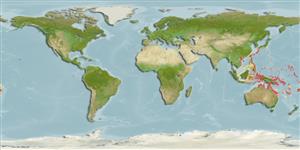>
Gobiiformes (Gobies) >
Gobiidae (Gobies) > Gobionellinae
Etymology: Redigobius: Latin,. Redere = to come back + Latin, gobius = gudgeon.
More on author: Herre.
Environment: milieu / climate zone / depth range / distribution range
Ecología
marino; agua dulce; salobre bentopelágico; dH range: ? - 8; anfidromo (Ref. 59012); rango de profundidad 0 - 5 m (Ref. 86942). Tropical; 25°C - 28°C (Ref. 2060)
Asia: Sri Lanka, Philippines, Malaysia and Indonesia (Ref. 13235); Japan (Ref.43239). Oceania: New Guinea. Reported from New Caledonia (Ref. 13235), Micronesia (Ref. 59012). Africa: Mozambique. Indian Ocean: Madagascar, Mayotte (Ref. 55749).
Tamaño / Peso / Age
Maturity: Lm ? range ? - ? cm
Max length : 3.8 cm SL macho / no sexado; (Ref. 44894)
Short description
Claves de identificación | Morfología | Morfometría
Espinas dorsales (total) : 7; Radios blandos dorsales (total) : 6 - 7; Espinas anales: 1; Radios blandos anales: 6. Distinguished by the following characteristics: moderate-sized Redigobius; single black band extending down and back from tip of first dorsal fin; distinct black band extending from eye diagonally across opercle to lower edge of pectoral fin base; first dorsal fin tall and elongate, third or fourth spine longest; opercle with small ctenoid scales; 14 circumpeduncular scales; second dorsal rays modally I,7; anal rays I,6; pectoral rays 16-17; longitudinal scales 23-25; TRB 9-11; predorsal scales 9-12 (Ref. 84480).
Adults inhabit coastal estuaries, lakes (Ref. 48637), and entering lower reaches of freshwater streams (Ref. 44894). Also found in quiet mangrove estuarine habitats (Ref. 84480). Also Ref. 43716.
Life cycle and mating behavior
Maturities | Reproducción | Spawnings | Egg(s) | Fecundities | Larva
Keith, P., G. Marquet, P. Valade, P. Bosc and E. Vigneux, 2006. Atlas des poissons et des crustacés d'eau douce des Comores, Mascareignes et Seychelles. Muséum national d’Histoire naturelle, Paris. Patrimoines naturels, 65:250p. (Ref. 57749)
IUCN Red List Status (Ref. 130435)
Threat to humans
Harmless
Human uses
Herramientas
Special reports
Download XML
Fuentes de Internet
Estimates based on models
Preferred temperature (Ref.
123201): 25.4 - 29.3, mean 28.6 °C (based on 1307 cells).
Phylogenetic diversity index (Ref.
82804): PD
50 = 0.5000 [Uniqueness, from 0.5 = low to 2.0 = high].
Bayesian length-weight: a=0.00977 (0.00442 - 0.02163), b=3.05 (2.86 - 3.24), in cm total length, based on LWR estimates for this (Sub)family-body shape (Ref.
93245).
Nivel trófico (Ref.
69278): 3.3 ±0.4 se; based on size and trophs of closest relatives
Resiliencia (Ref.
120179): Alto, población duplicada en un tiempo mínimo inferior a 15 meses (Preliminary K or Fecundity.).
Fishing Vulnerability (Ref.
59153): Low vulnerability (10 of 100).
